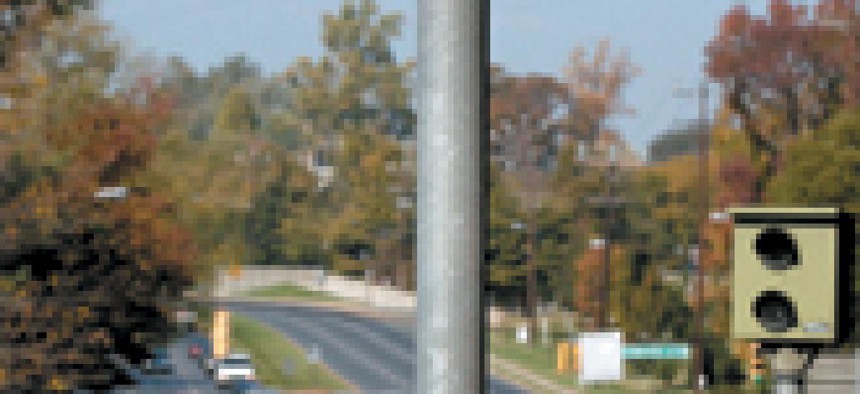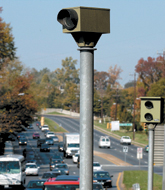Red-Light Cameras Get A Green Light

Red-light camera systems are enjoying increasing public acceptance as a cost-effective way to reduce traffic accidents, despite complaints that the systems constitute a shakedown of motorists by local governments and the makers of the systems.
Red-light camera systems are enjoying increasing public acceptance as a cost-effective way to reduce traffic accidents, despite complaints that the systems constitute a shakedown of motorists by local governments and the makers of the systems.Traffic cameras, both digital and video, are deployed in about 50 jurisdictions throughout the country, according to government and industry officials. They said the camera systems have strong support from the law enforcement community, because the systems allow police to decrease personnel assigned to red-light enforcement while still ensuring public safety. Consequently, these officials expect demand for the camera systems to rise in the aftermath of the Sept. 11 attacks.Local law enforcement resources are being reallocated to anti-terrorism activities, and jurisdictions "can't afford to have officers sitting in [patrol] cars at traffic lights," said John Fortuna, director of national law enforcement programs for Electronic Data Systems Corp., Plano, Texas, a provider of the red-light camera systems.Maury Hannigan, senior vice president of the public-safety solutions division for Affiliated Computer Services Inc. of Dallas, agreed, saying that red-light cameras at intersections with a high volume of "red-light running" can do the work of three or four officers. "There is unlimited growth opportunity in the field [of red-light enforcement]," he said.ACS entered the red-light camera arena when it acquired Lockheed Martin IMS in July. The company has 55 contracts in the United States and Canada, including local jurisdictions in about nine states and Washington, D.C., Hannigan said.ACS declined to disclose how much it has made from any of its contracts, but Washington officials said IMS and ACS have been paid $5.36 million on that deal alone. EDS' Fortuna also expects strong growth in the United States and abroad during the next 12 to 18 months. The inquiries about red-light solutions are triple what they were last year, he said.EDS often teams with Nestor Inc., Providence, R.I., to provide red-light traffic systems. Nestor provides the front half of the solution involving deployment of video cameras, and EDS provides the back half that includes processing the images and mailing the citations, he said. ACS offers its customers both the front and back end, company officials said. Nestor has eight customers located in California, Iowa, Kansas and Virginia. EDS has 23 customers scattered throughout Maryland, North Carolina and Virginia, Fortuna said.When EDS is not partnered with Nestor, it provides back-end solutions for companies such as Peek Traffic Inc. of Sarasota, Fla., and TraffiPax Inc. of Danvers, Mass., Fortuna said. Fortuna declined to disclose how much of EDS' $1 billion state and local business is derived from red-light camera-related solutions. The strongest growth opportunities for EDS are in California and Maryland, he said.The red-light camera technology has been available for more than a decade, but adoption has been slow because it arouses fierce opposition from some citizens and politicians. In San Diego, for example, a lawsuit filed in February seeks reimbursement on behalf of anyone who has ever received a red-light citation from the city since its photo enforcement program began in 1998. Although a superior court judge in August ruled the program was constitutional, city officials have suspended the program pending the outcome of an independent audit that will be sent to the city council in November, police officials said. In May, House Majority Leader Dick Armey, R-Texas, lashed out against various types of photo enforcement when he learned the National Park Service was conducting a pilot project for radar cameras on park roads in Virginia. He expanded his attack to include local jurisdictions that use photographic or video cameras for law enforcement purposes. Armey contended there is no clear evidence the cameras are effective, they deprive citizens of their right to face their accusers in court, and they are profit-making mechanisms for both local governments and private companies. Despite such opposition, company officials are optimistic there will be an abundance of new contract awards. And opportunities are just as likely to be found in towns and suburbs as they are in major cities, said David Fox, president and chief executive officer of Nestor."Some very small cities can have pretty big problems," Fox said. "Just as cities have rush-hour problems, suburbs also have problems. Some small cities may have one or two intersections that are frightening their citizens."Fox said some of the market growth will come from jurisdictions that already deploy the camera systems. "Not only do they want to keep it, but they want to expand the number [of cameras]," he said.Nestor offers its customers a choice of funding models that include sale or lease of equipment or a transaction-based approach based on the number of citations processed.Nestor has more than 60 employees and annual revenue of about $5 million, Fox said. He declined to disclose the company's growth forecast. About 12 states have laws on the books that address the use of photos or video to apprehend violators for speeding or red-light infractions. Among them are Arizona, California, Colorado, Hawaii, Maryland, North Carolina and Virginia. Typically, a change in state law is required before a local jurisdiction can use photo enforcement. This is because running a red light is a moving violation that must be observed by an officer. State laws decriminalize the offense by removing points charged against the driver's license. In most states the owner of the vehicle is fined rather than the driver. The exceptions are Arizona, California and Washington, D.C., where a photo of the driver is taken, and points are assigned to his or her license.Some states are revising their laws. Another six are considering legislation that would authorize using cameras for motor vehicle law enforcement, industry officials said.Red-light monitoring is part of the continuing automation of law enforcement, said Robert Atkinson, director of the New Economy and Technology Project at the Progressive Policy Institute, a Washington-based research organization. He said the real issue is not the technology but how it is managed. "The issue is not that private contractors are carrying out the program, but under what rules they are doing it and how closely they're monitored," Atkinson said. He said governments have a responsibility to their citizens to exercise strong management over these programs.XXXSPLITXXX-Officials with Affiliated Computer Services Inc. are hoping that San Diego will resume its red-light photo enforcement program following an independent audit and report due to the city council in early November. San Diego officials halted the program in June in the face of rising complaints that the technology was unproven, and the city's financial arrangement with the contractor was questionable.Opponents contend that, because ACS receives a percentage of the fines collected on each ticket, the company was operating the program in ways intended to raise the maximum revenue possible for it and the city. Motorists in February filed a lawsuit challenging the program.Although Superior Court Judge Ronald Styn ruled in August that the red-light program is constitutional, he said more stringent procedures are needed before it can start up again. The original contractor providing the photo enforcement system, Lockheed Martin IMS, was purchased by ACS of Dallas in July. ACS officials predict the program will resume early next year, but police officials aren't willing to go that far. "It's premature to say at this point whether the program will work or not," said San Diego Assistant Police Chief William Maheu. The judge's ruling will be an asset to photo enforcement in the long run, said Maury Hannigan, senior vice president of ACS' public-sector solutions division. This is because the judge ruled that the program was constitutional, and that the problems with the city's programs can be easily fixed, he said."Contrary to what has appeared in the media, the judge's ruling was a positive decision for red-light camera enforcement," he said.Partly because of the San Diego experience, ACS plans to move away from a transaction-based funding model for red-light enforcement projects to a more traditional funding model. It would require jurisdictions to pay what Hannigan characterized as a "flat fee" for the solution. Maheu said the engineering firm conducting the audit is checking to see if the technology is functioning properly, and will establish criteria to select the intersections where the cameras will be installed.San Diego experienced a 45 percent drop in red-light violations after the cameras were installed in 1998. The city was planning to increase the number of intersections with red-light photo enforcement from 19 to 32, he said."If you can [reduce violations] with a simple technology advancement, then that makes one heck of a statement," Maheu said.




Maury Hannigan

Camera systems such as this one in Rockville, Md., let police reallocate personnel away from red-light enforcement to other needs.

Maryland is one of 12 states using photos or video to apprehend violators for speeding or red-light infractions.
NEXT STORY: STATES OF OPPORTUNITY

